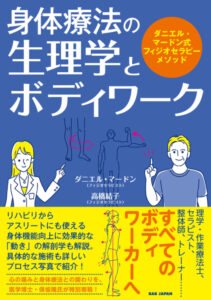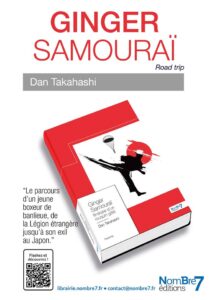【Exploring the spirit of the Ryukyu】Series 9 (HIDEN 01/2024)「Kuba Yoshio SENSEI」
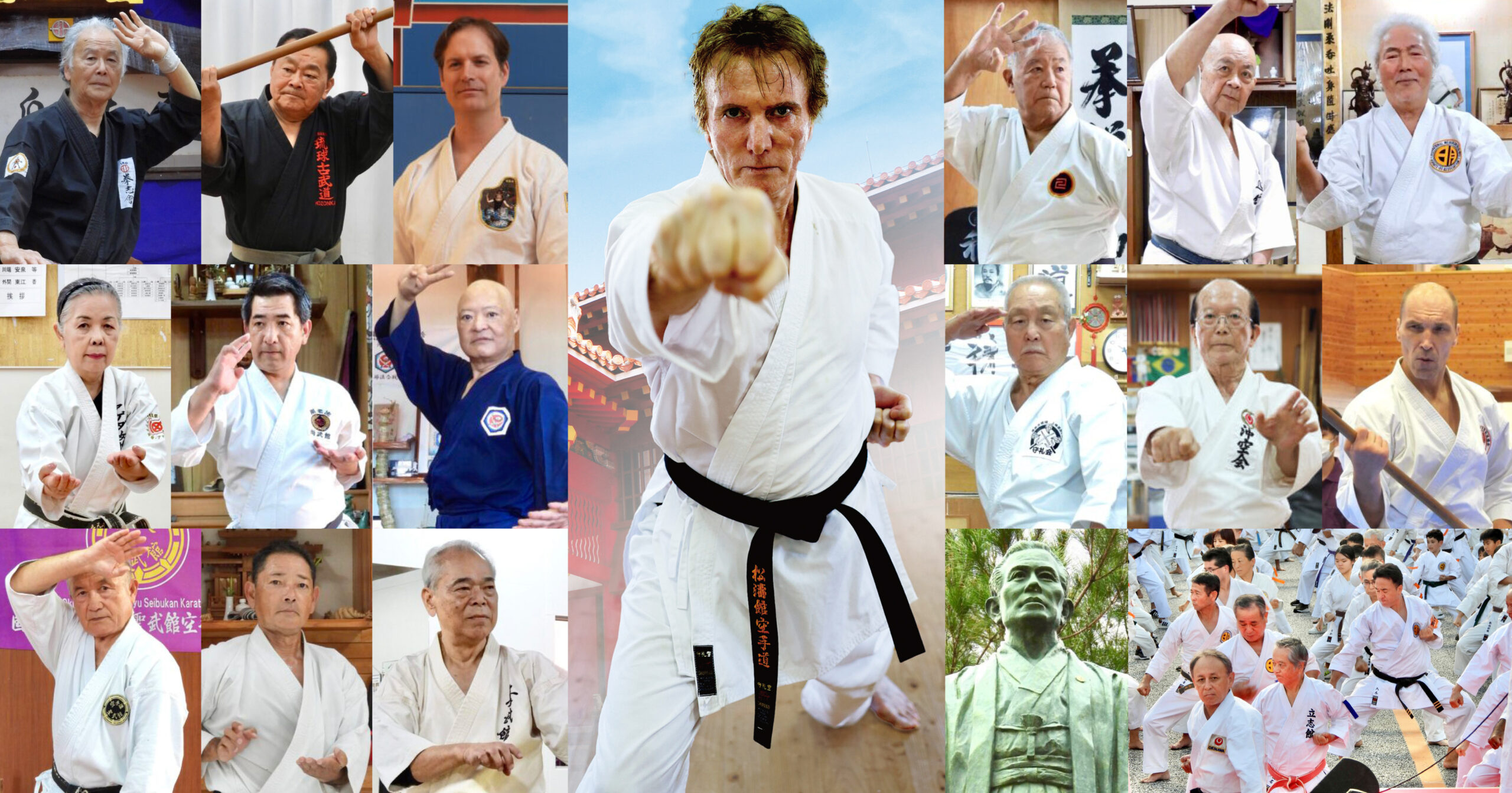
【Exploring the spirit of the Ryukyu】Series 9 (HIDEN January 2024)「Kuba Yoshio Sensei 10th Dan & Kancho Kenpokai Kenbukan」
Interview/Writer: Daniel Mardon
Photography/translation: Yuko Takahashi
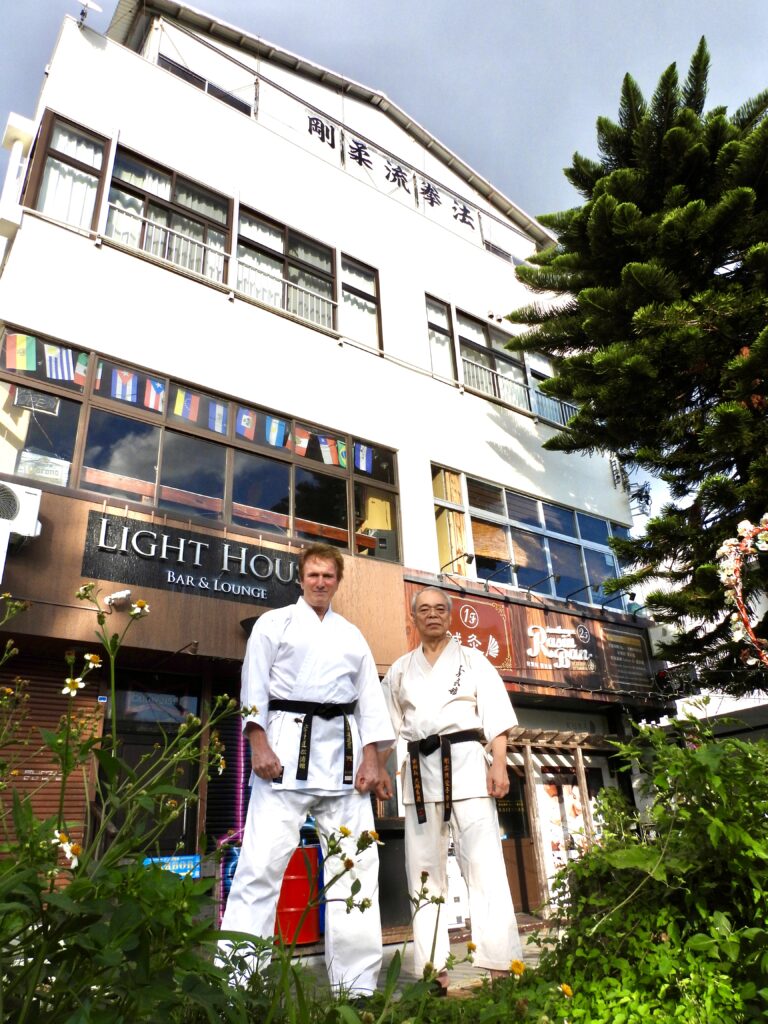
Kancho Yoshio Kuba and Daniel Sensei standing in front of the Okinawa Karatedo Kenpo Kai Kenbukan building. The words “Goju-ryu Kenpo” on the top can be clearly seen from Koza Gate 2 Street.
Today, we are visiting another famous traditional Dojo in Koza, Okinawa. Situated on that large avenue referred to as “Gate 2” by local people, we are therefore at the door of Kadena USAF base.
The Dojo is perched on the top of a 4 story-building painted in white like a Do-Gi. We can read in big Kanji; “Goju-Ryu Kenpo”. This architecture feels odd on this avenue because it looks like a chalet from the Swiss-Alps and the effect is accentuated by the presence of 2 tall and beautiful columnar Cook pines.
I am very happy to write an article not only about another famous Karate Master, but also about a professional therapist. For once, I share 2 big common passions with my interlocutor; Karate and the science of the body. Yoshio Kuba Hanshi is a pharmacologist and a renowned acupuncturist. Actually, his salon-clinic is at the bottom of the building and this is where Yuko Takahashi and I are starting our interview.
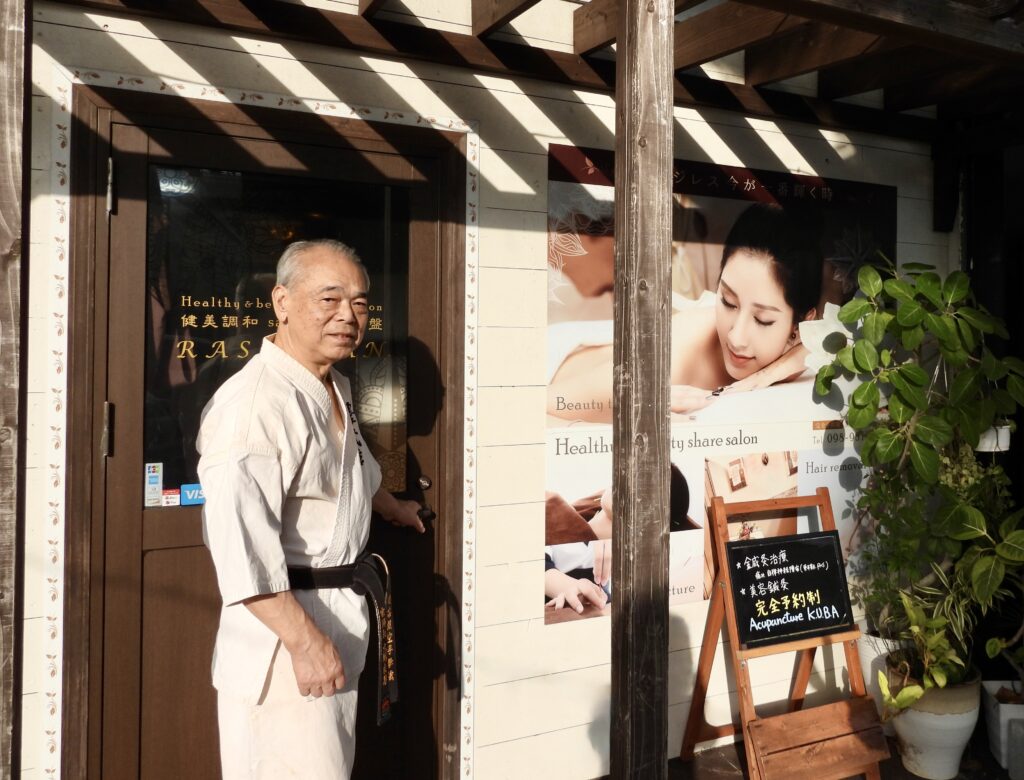
Kuba Sensei at the door of his salon-clinic
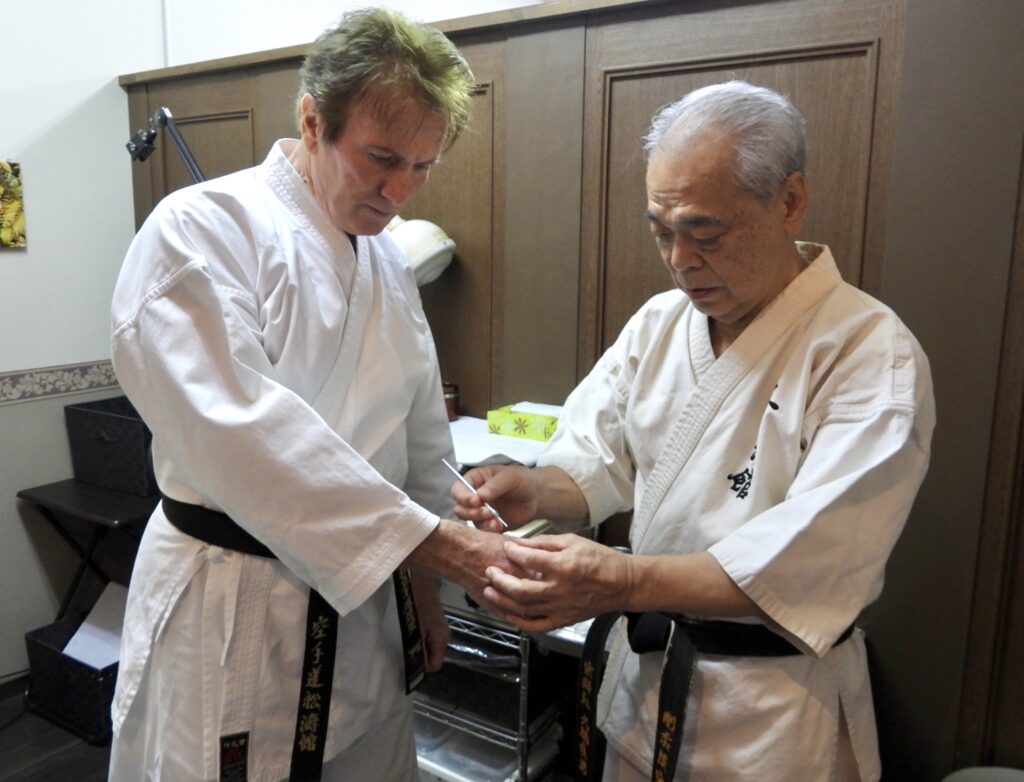
Acupuncture demonstration by Sensei Kuba in the treatment room on the first floor.
The vision of 3 persons in Karate Gi talking therapies is quite surprising for the staff and passersby.
Since we are at that spiritual moment of entering a new-year, Kuba Sensei tells me a beautiful secret concerning the names of Okinawan Kata and their subtle connection to Buddhism…
For example the Kata “Seisan” (in Kanji 十三) reads “Jyusan”, which means 13. It is important to know that there are 13 sects in Buddhism. Another example; the Kata Suparinpei/壱百零八手 reads “108 hands”. It refers to the number of our passions and desires.
At New Year’s Eve, in Japan, the bells are rung at midnight 108 times in order to exorcise these passions that confuse people’s minds and cause them trouble and suffering.
Another Kata; Gojushiho/五十四歩 reads “Fifty-four-steps” (54) and is half of that previous number. One more is about the Kata Sanseiru/三十六手, that reads “Thirty-six hands” (36) and represents one third, etc.
I am learning some very interesting things but it is time to climb (the stairs are pretty steep!) to the 4th floor where some students are already warming up in the Dojo. There is a great attendance of advanced belts from all over the world tonight and since I have little experience in Goju-Ryu, I think I will hide in the back… but since I am a guest Kuba Sensei invites me to the front row.
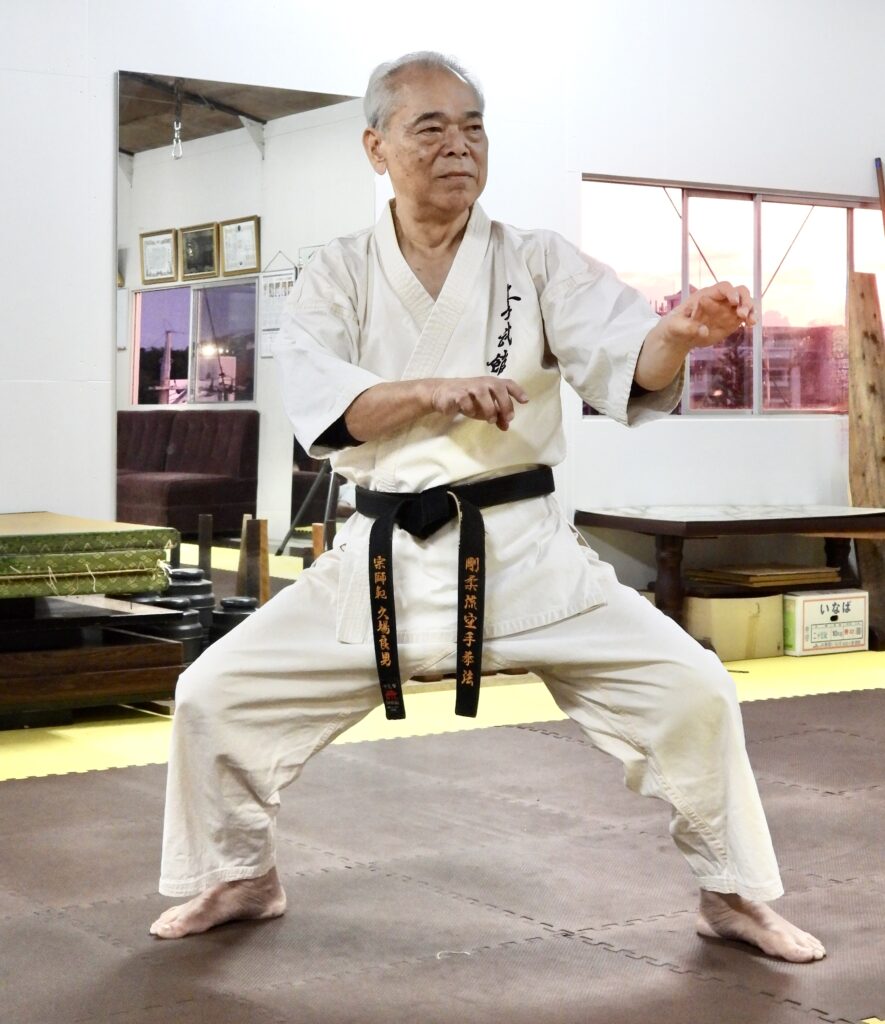
BIOGRAPHY
Kuba Yoshio Hanshi 10 dan, Kenbukan Kancho.
Ryukyu karate kobujustu Kokusai shihankai kaicho
Okinawa karatedo kenpokai kaicho (Chairman)
Okinawa Karatedo Federation Adviser
Okinawa Goju-Ryu Kenpo Grand Master
Director of Ryukyu Martial art Academy
(1-) How did you start karate?
It all started when a friend of mine started Karate and I wanted to try it myself. I was 15 years old. At that time, I was very much into kendo, but not into Karate. However, I tried Karate for a while, but this is really when I went to the University in Nagoya that I took Karate seriously. Despite having a short experience in Okinawa karate, I felt that there was a big difference with mainland Karate. The practice there was Shito-Ryu.
After graduating, I also studied acupuncture in Osaka and when I returned to Okinawa at the age of 26, I missed Karate-practice, so I went back to my first Dojo; the Shōreikan Dojo with Goju-ryu Toguchi Seikichi Sensei (1917-1998 founder of Shōreikan).
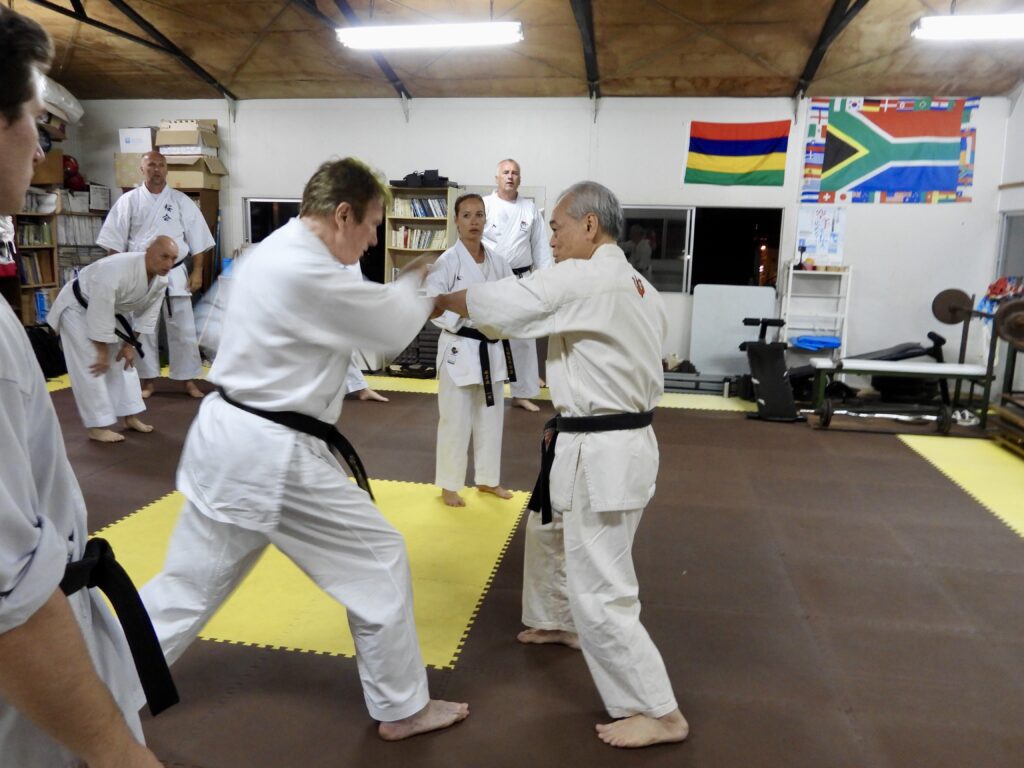
Kuba Sensei invites Daniel Sensei to attack and demonstrates his uke.
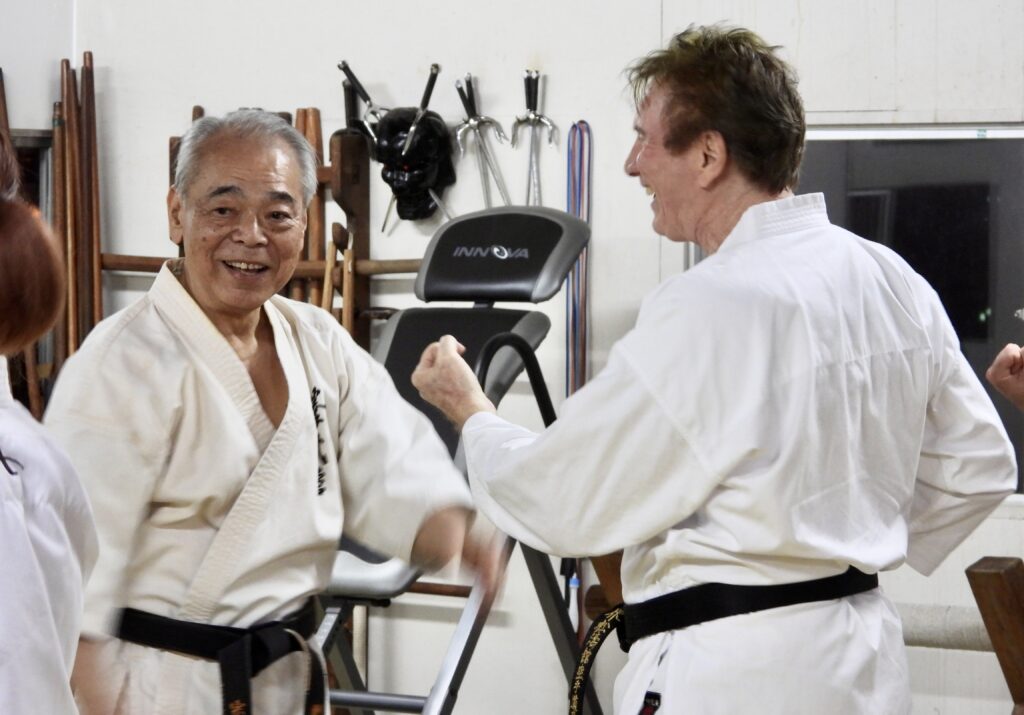
Kuba Sensei is always calm and friendly even during tough training sessions.
(2-) What are the characteristics of your school (Dojo)?
It teaches basics (Kihon), Kata and Kumite based on Kata.
In mainland Japan, there is a common belief that Kata is Kata and Kumite is Kumite, but the fact is that all techniques are derived from Kata.
A technique from a Kata is actually a single movement that is part of several other linked movements. In Kumite it is accepted that a technique can change a bit and be adapted according to the situation; like the distance or the orientation of the fighters for example.
Nowadays, in competition Kata, the techniques are standardized and you are judged about how big and beautiful they are. However, these techniques cannot be applied in Kumite, so that is why Kata should be more realistic.
In the old days in Okinawa, Kumite was called “hendi” 変手. It was an Okinawan Karate word that can be easily translated in Japanese by
変 “Hen”: change, to change and 手 “Ti/Di”: hand
For us in Kumite, the form should remain the same (as in a Kata), but the technique can be slightly adapted. The change is usually so subtle that it is not visible. It was said that if you couldn’t do “Hendi”, you were unable to use Karate in Kumite.
My philosophy is therefore that “If you cannot use a technique from a Kata, what you do is not Karate Kumite.!” I therefore teach my students to be able to do “Hendi”.
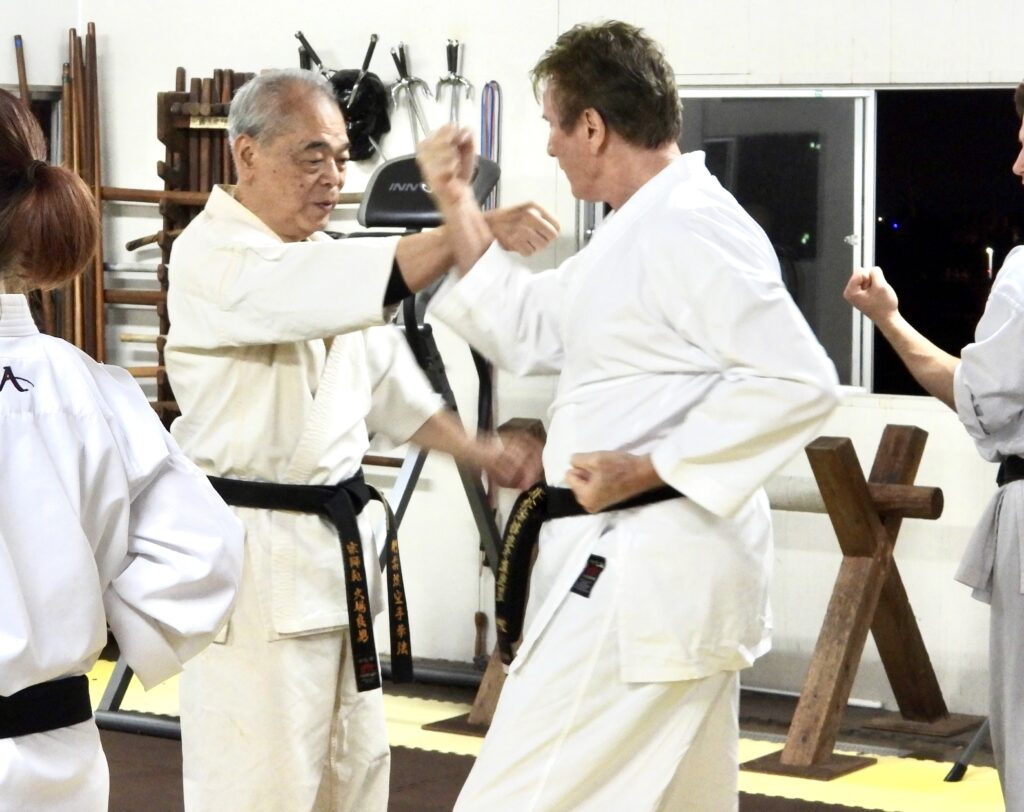
Kuba Sensei demonstrating block & punch
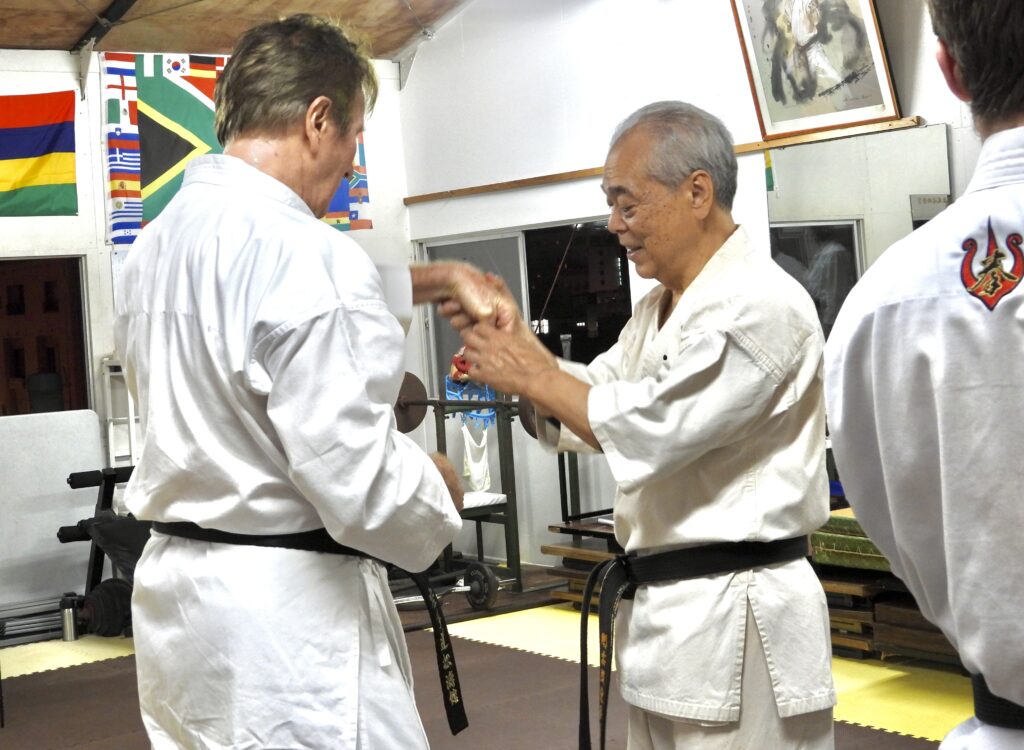
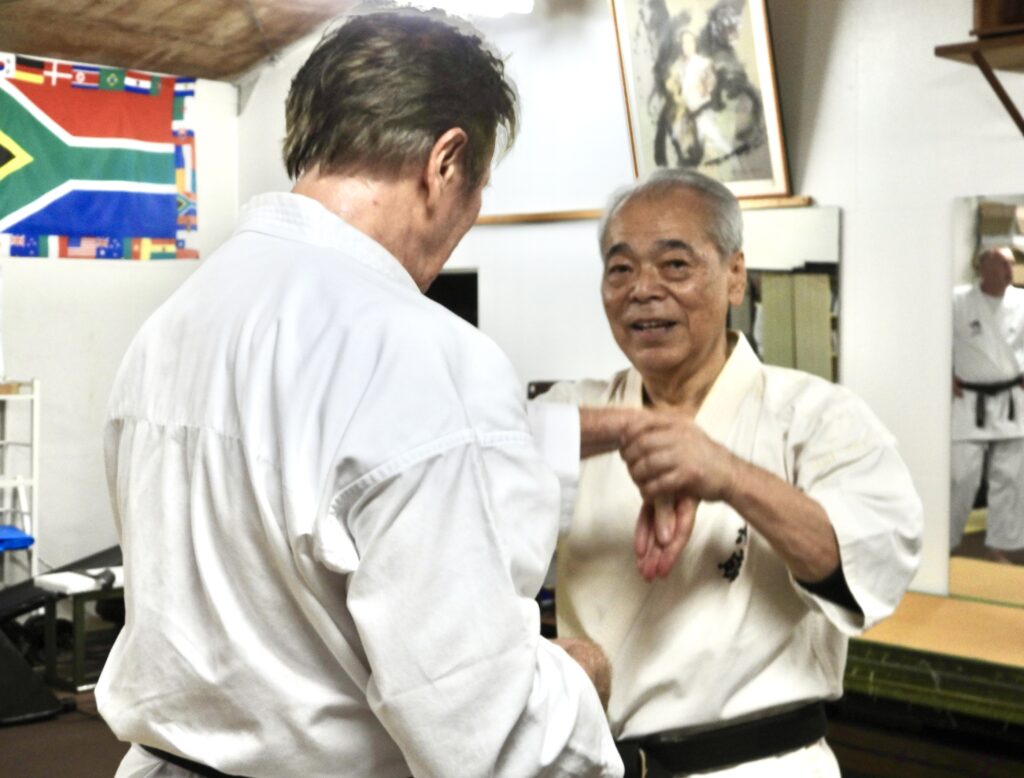
Kuba Sensei is showing the secret Goju-Ryu-hand.
(3-) What is your favorite Waza and Kata?
When I was younger, I was good at “Seisan”, but now I am better at “Shisochin” and “Sanseiru”. My favorite Kata are still “Seisan” and “Sanseriu.” I like the grandeur of Goju-ryu.
In the past, it was said that if you practice Karate just for the fun of it, it would still be a good idea to reach Seisan level. Only once you are good at it, you have become a true Karateka and then you can aim at becoming an expert.
Seisan is the basis of Karate and is an important step that every Ryuha has.
In Shotokan, Gichin Funakoshi Sensei changed the name to “Hangetsu” 半月(half moon)…
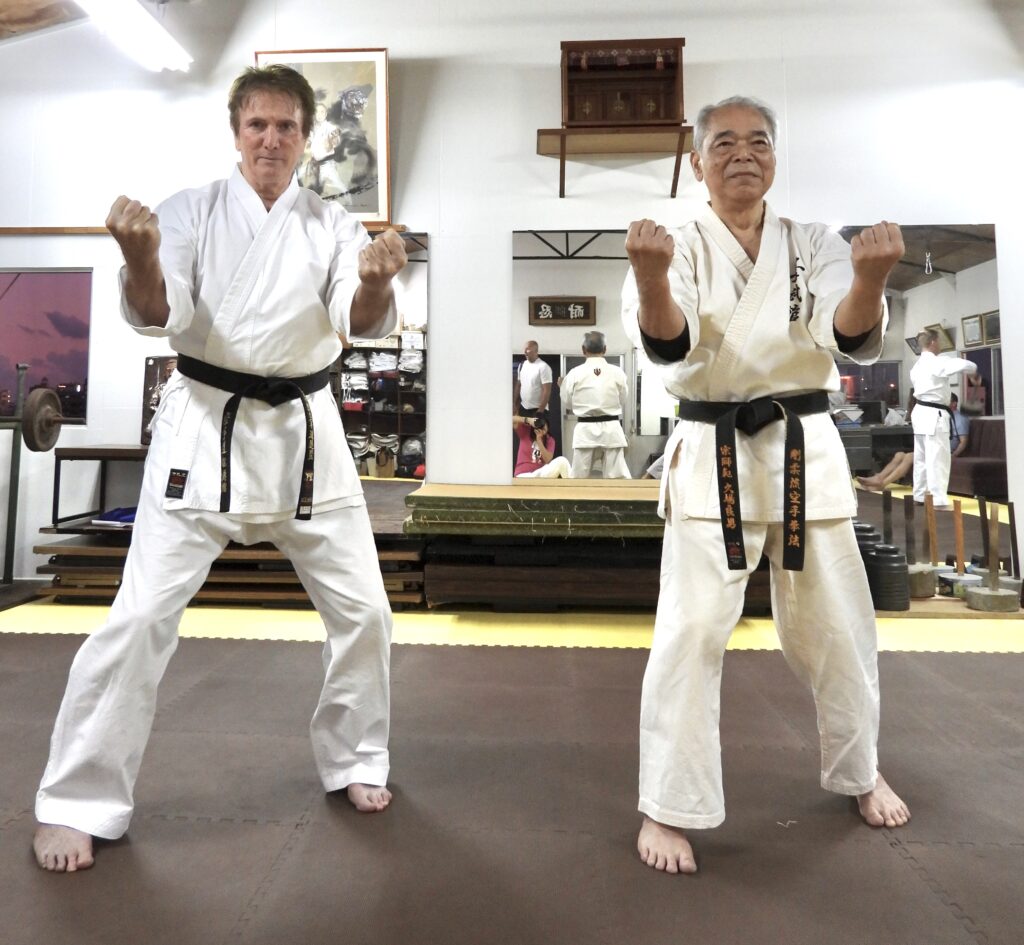
Sanchin kamae. After being coached by Kuba Sensei, Daniel Sensei, who is a Shotokan-practitioner, takes on the Sanchin stance.
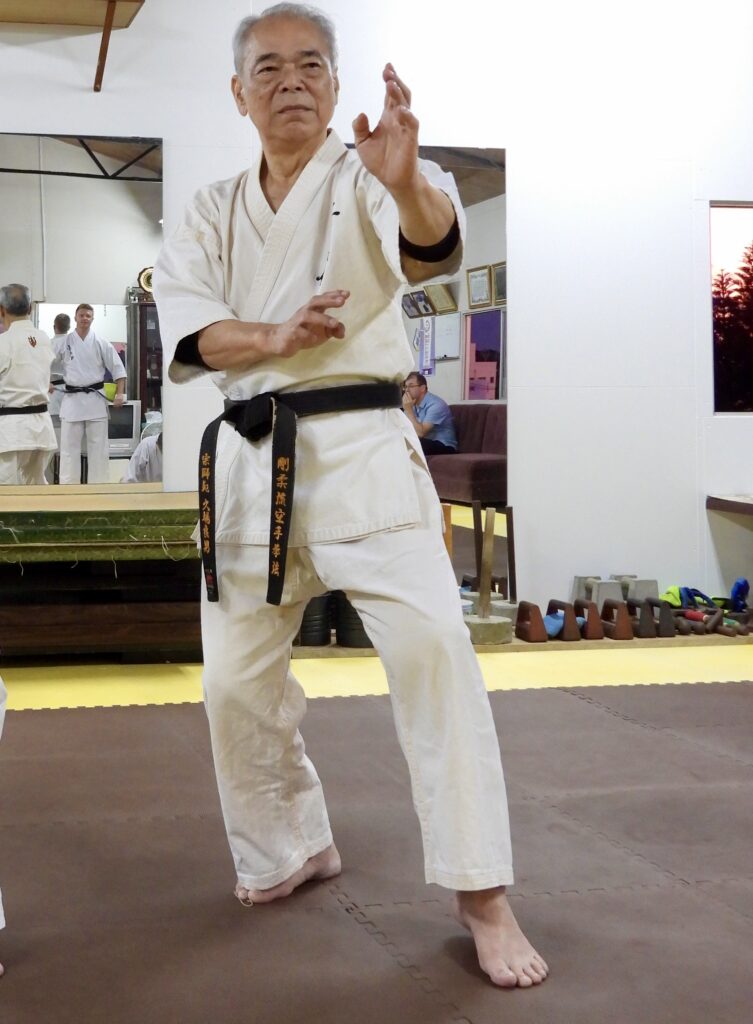
Kuba Sensei’s special moving stance.
(4-) What is your most impressive memory of your Sensei/(Shisho)?
My Shisho is Seikichi Toguchi. My favorite memory is that there were many days when it was just the two of us in the Dojo. I was forced to do “Sanchin” on the full length of the 12 x 8 meters Dojo while getting repeatedly hit from behind. Normally, when you perform the Kata Sanchin in a group, the rule is to move forward three times and then to rotate and do it three more times. When you are alone and the Master says: “Mae!”, you move forward and you have no other choice. To reinforce your positions and your body, he hits you and that is normal. However, even when he asked me to “Go forward!” he kept hitting me from behind. It made me lose track of how many times I turned around and advanced and by the end of the exercise I was completely dizzy. At that point, I had a strange feeling. Near the end of that strenuous Kata-exercise, my senses seemed to have become sharper and I was able to notice signs and movements behind me. I wondered if Sanchin can bring such an effect.
Toguchi Sensei was able to watch your Kata until the end without blinking an eye. Actually, he could hold it for 4 to 5 minutes and I was very good at it too. It is a good discipline to have, because if your opponent attacks you at the moment you blink, you won’t be able to block or react.
Also, Shisho likes to drink, and I was the only one able to hang out with him until the end. While drinking in his company, I was also taught secret techniques that he wouldn’t normally teach in class…
Toguchi Sensei was a disciple of Higa Sekō Sensei (1898-1966) and Sekō Sensei loved him very much. Sekō Sensei often came to the Shōreikan Dojo and was giving us guidance. At that time, there were quite a few teachers who went to other Ryuha Dojo and we could practice and interact with them. It was a time when no one called themselves a member of a Ryuha, so I didn’t think there was any particularity among styles.
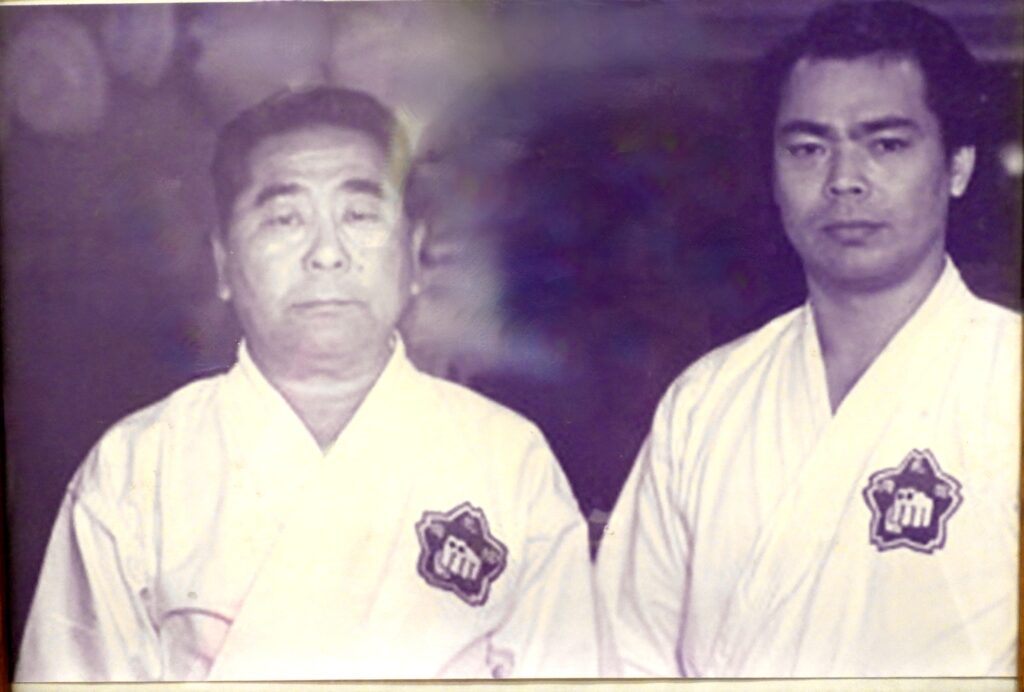
Toguchi Seikichi (left) and Kuba Sensei (circa 1974) at Shisho Toguchi Sensei’s Shōreikan Dojo.
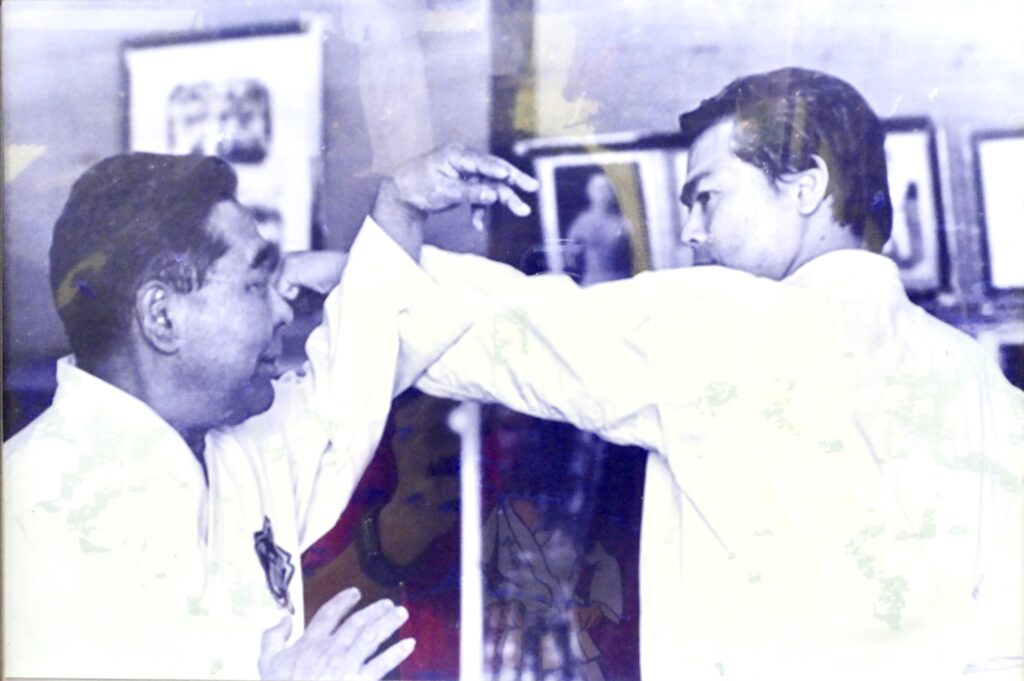
Toguchi Sensei teaching the same technique to young Kuba Sensei
(5-) What is the difference between Okinawa Karate and mainland Karate?
In the past, Karate on the mainland was mainly competitive, and Karate in Okinawa was mainly traditional Karate, but recently people from the Kumite lineage of the mainland come to my Dojo because they want to practice Kata properly. Okinawa Karate is also changing and opens more for teaching its techniques. So both places are gradually changing their concept.
(6-) Do you often teach to foreigners?
Currently, the majority of my students are foreigners. We have branches in South Africa, Australia, Mauritius, India, Belgium, Germany, Slovakia, Hungary, Switzerland, Romania, Russia and more and I will open a branch in France next year.
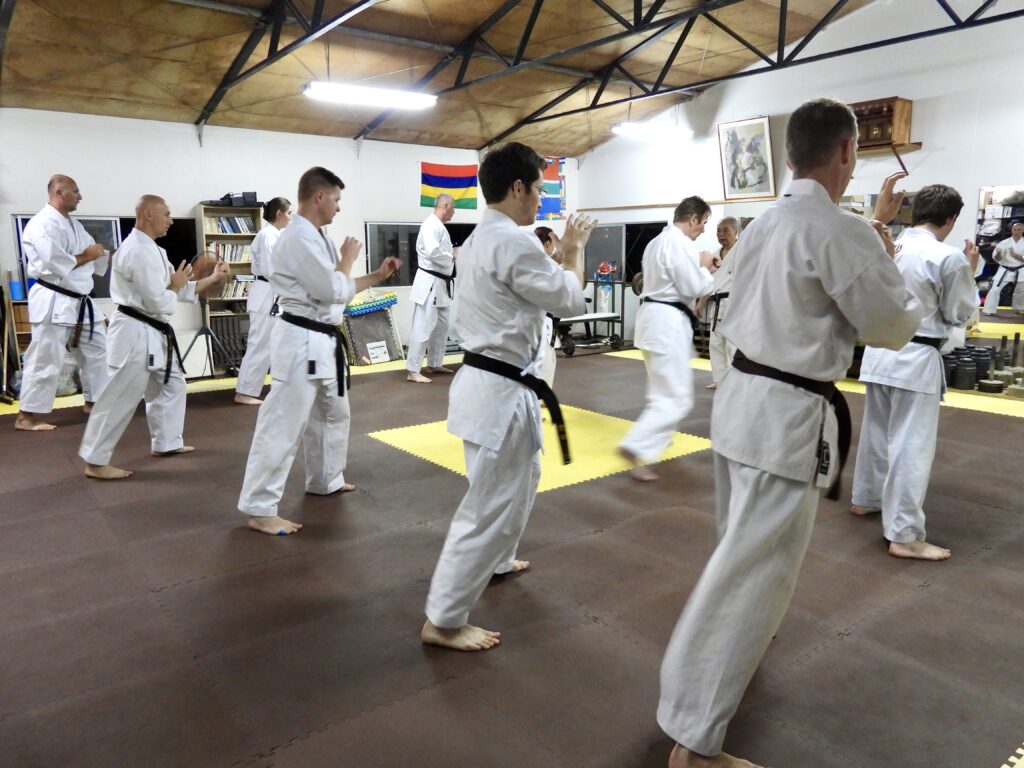
In a tense atmosphere, hard practice with many series & reps.
(7-) What do you think about the globalization of Karate?
I’m happy, but when I’m teaching overseas, I sometimes come across bunkai that is way too wrong. I tell them : “Guys, is this bunkai really right? Do you really think you can stop someone with this…?” When they actually try it on me, they find out that it’s not realistic at all… My mission is to teach the correct interpretation and I tell people to practice the real thing, but unreal bunkai has spread all over the world. Bad Bunkai are now taken for granted as a technique and it gives a bad image to Karate.
(8-) What do you think about Karate becoming a competitive sport, including the Olympics?
I know from experience that if you play competitively when you are young, you will improve greatly in the future, so I am not ruling out becoming competitive. However, I would like competitors to acquire proper technical knowledge after a certain age. There was a time when I was in the competitive world myself, but now I’m in the martial arts of Karate.
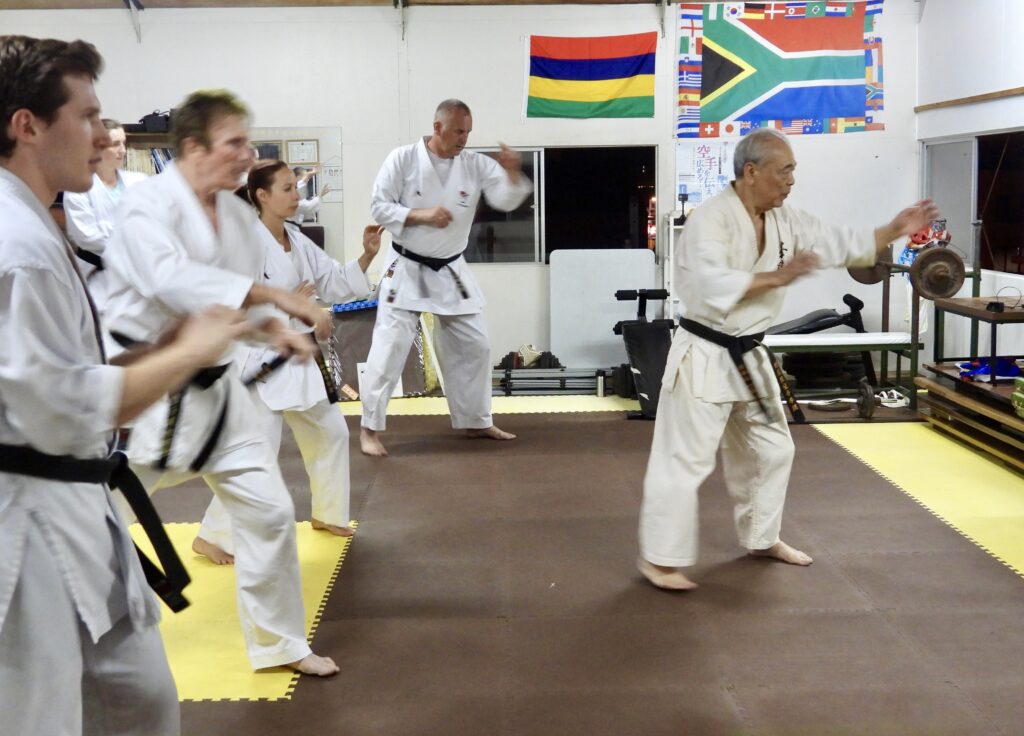
Kuba Sensei demonstrating moving stances.
(9-) What does today’s Karate mean to you?
It is necessary to be able to defend yourself so that you do not let the other person to become a criminal, but you don’t want to become a criminal yourself. If I hit someone, I would be the criminal, so I will parry and gently take him down. However, if I cannot do that nicely, I will throw him down with a stronger “Torite”(extrication) or “nagewaza” (projection)… After knowing that, do you still want to fight me? That’s right; Martial Arts Karate can do that.
Currently, in the world of competitive sport Karate, only 20% of the techniques are used and 80% are dead. That is why it is important to learn Kata and Bunkai. But in order to reach the full knowledge of the techniques, you must continue practicing.
(10-) How do you envision the future of Karate?
Sport-Karate will continue to expand. There is a problem with the rules, and I don’t necessarily agree with the way things are now, but the rules change with time, so I am looking forward to seeing them change for the better.
My concern is that in Okinawa, there are not many people over 30 who are willing to learn and to devote themselves to proper traditions.
There are many people overseas who have become my students and are eager to learn Martial Arts Karate. They keep saying; “I can only teach Karate-competition…! I want to teach Martial Arts Karate to middle-aged and older people who want to continue Karate.” They are usually former Jiyu Kumite European champions who are running prestigious Dojo.
I hope that the traditional form of our art will continue to exist in Okinawa, the birthplace of Karate.
(11-) Do you have any message for the world?
I want the younger generation to learn how to compete in the world of sports so that they will not be the type to give up in the competitions of our societies. I also hope that once a Karateka reaches the age of 30, he can aspire to the true “traditional way of Karate” and learn Karatedo that he can pass on to the next generation.
(12-) What does “Karate” personally mean to you ?
Karate is life/人生 “jinsei”. If I hadn’t done Karate, I wouldn’t be where I am today. I really like Karate and enjoy it.
Daniel’s conclusion:
I have learnt new things again today! The true martial spirit that lies behind the historical Okinawan Karate is really about avoiding fighting. I am not sure World-Karate understands this…?
The difference between Sport-Karate and Martial Arts Karate is clear.
I am also impressed by the deep ancient custom of Okinawan Karate, which was to practice until at least the level of Seisan Kata (Hangetsu) and to decide to continue or not on the path in order to reach higher levels.
Domo arigato gozaimashita Sensei for today’s wonderful time & interview.
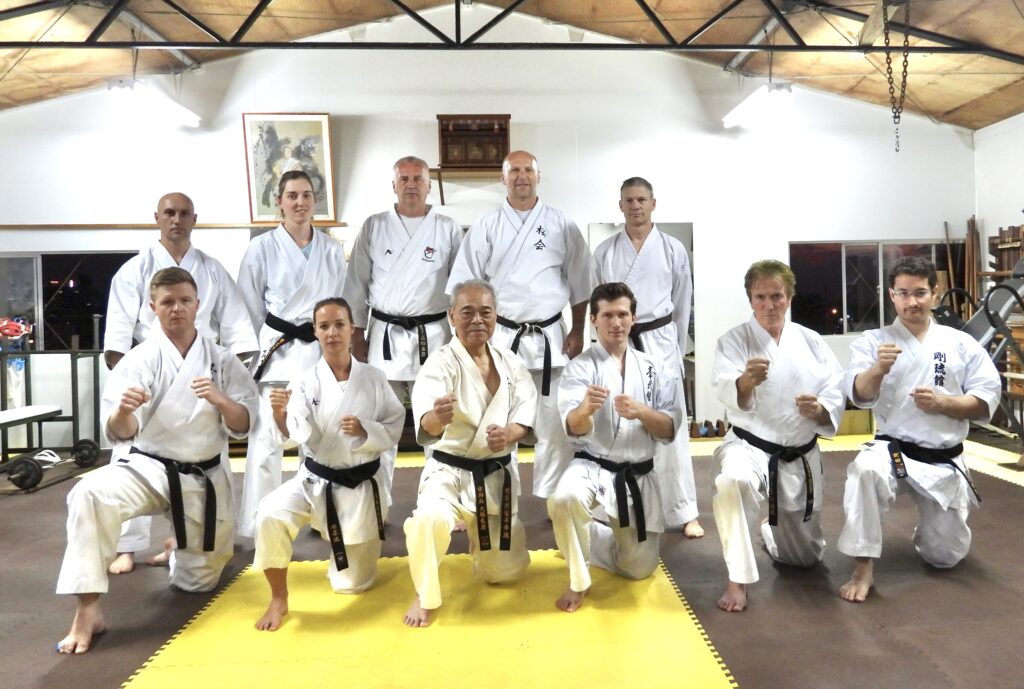
Group picture with the students of Okinawa Karatedo Kenpokai Kenbukan Dojo.
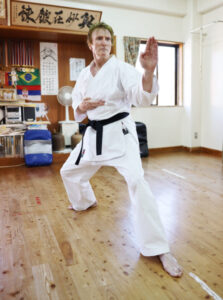
Daniel Mardon; the Karateka-Therapist
Creator of Aromapressure® method and physiotherapist with a valid US license, Daniel Mardon was born in Paris. One of his specialties is to teach and to perform lymphedema and subcutaneous tissue-damage care, after radiotherapy for cancer patients at medical institutions and subcutaneous tissue-circulation stimulation before and after surgery.
He was also a therapist for two famous soccer teams in Paris. Since 2005, he has focused on producing top-class hotel spas in Japan, as well as physiotherapy education and awareness-raising activities for health care professionals. Author of several books, among his major publications includes “The Physiology and Bodywork of Physical Therapy ” (Published by BAB Japan) and DVD “Daniel Mardon Aromapressure® Method ” (Pony Canyon). He regularly appears on television and radio shows, and has featured in numerous media publications.

